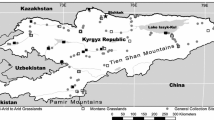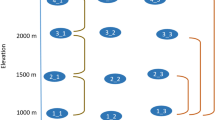Abstract
It has been suggested that variation in the proportion of species in guilds (=guild proportionality) indicates community structuring by guilds in biotic communities. This hypothesis was tested on a subthermophilous grassland and a mesotrophic meadow at a scale of 0.09 m2 based on a five-year data set. Further, variation in the total number of species, variation in the number of species belonging to a guild and non-randomness in species composition of guilds were studied. A number of criteria for guild definition were used, such as life form, Grime's C-S-R strategy, phenology, plant height, pollination and dispersal syndromes, leaf shape and anatomy and taxonomy at the family level.
The observed variation in the number of guild species corresponded to the null model in which species assemblages with fixed species richness per square were randomly generated from the species pool. The observed variation in the number of guild species was often higher than the variation calculated for randomly distributed species whereas the variation in the proportion of guild species was in some cases lower than the variation calculated for randomly distributed species with fixed frequencies. Possible reasons for the discrepancy in the results based on different models are discussed. It is concluded that there is little evidence of guilds in the organization of grasslands. *** DIRECT SUPPORT *** A02DO006 00012
Similar content being viewed by others
References
Bycroft C.M., Nicolaou N., Smith B. &Wilson J.B. (1993): Community structure (niche limitation and guild proportionality) in relation to the effect of spatial scale, in aNothofagus forest sampled with a circular transect.—New Zealand J. Ecol. 17: 59–65.
Cohen J.E. (1977): Ratio of prey to predators in community food webs.—Nature 270: 165–167.
Dostál J. (1948-1950): Květena ČSR (Flora of Czechoslovakia).—NČSAV, Praha.
Evans F.C. &Murdoch W.W. (1968): Taxonomic composition, trophic structure and seasonal occurrence in a grassland insect community.—J. Anim. Ecol. 37: 259–273.
Fagerström T. (1988): Lotteries in communities of sessile organisms.—Trends Ecol. Evol. 3: 303–306.
Fowler N. (1981): Competition and coexistence in a North Carolina grassland. II. The effects of the experimental removal of species.—J. Ecol. 69: 843–854.
Frank D. & Klotz S. (1988): Biologisch-ökologische Daten zur Flora der DDR.—Wiss. Beitr. Martin-Luther-Univ. Halle-Wittenberg, 1988/60 (P35), 103 pp.
Gause G.F. (1934): The struggle for existence.—Baltimore.
Gitay H. &Agnew A.D. (1989): Plant community structure, connectance, niche limitation and species guilds within a dune slack grassland.—Vegetatio 83: 241–248.
Goldberg D.H. &Werner P.A. (1983): Equivalence of competitors in plant communities: a null hypothesis and a field experimental approach.—Amer. J. Bot. 70: 1098–1104.
Hubbell S.P. &Foster R.B. (1986): Biology, chance, and history and the structure of tropical rain forest tree communities.—In:Diamond J. &Case T.J. [eds.]: Community ecology, Harper & Row, New York, pp. 314–329.
Jeffries M.J. &Lawton J.H. (1985): Predator-prey ratios in communities of freshwater invertebrates: the role of enemy free space.—Freshwater. Biol. 15: 105–112.
Jongepierová I., Jongepier J.W. &Klimeš L. (1994): Obnova druhově bohatých luk v Bílých Karpatech (Restoration of species-rich meadows in the Bílé Karpaty Mountains).—Příroda, Praha, 1: 7–21.
Marsaglia G., Narasimhan B. &Zaman A. (1990): A random number generator for PC's.—Comp. Physics Comm. 60: 345–349.
Murray K.G., Feisinger P., Busby W.H., Linhart Y.B., Beach J.H. &Kinsman S. (1987): Evaluation of character displacement among plants in two tropical pollination guilds.—Ecology 68: 1283–1293.
Palmer M.W. (1987): Variability in species richness within Minnesota oldfields: a use of the variance test. —Vegetatio 70: 61–64.
Pielou E.C. (1972): 2k contingency tables in ecology.—J. Theor. Biol. 24: 337–352.
Root R.B. (1967): The niche exploitation pattern of the blue-grey gnatcatcher.—Ecol. Monogr. 37: 317–350.
Schluter D. (1984): A variance test for detecting species associations, with some example applications.—Ecology 65: 998–1005.
Silvertown J. &Law R. (1987): Do plant need niches? Some recent developments in plant community ecology.—Trends Ecol. Evol. 2: 24–26.
Simberloff D. &Dayan T. (1991): The guild concept and the structure of ecological communities.—Annual Rev. Ecol. Syst. 22: 115–143.
Terborgh J. &Robinson S. (1986): Guilds and their utility in ecology.—In:Kikkawa J. &Anderson D.J. [ed.]: Community ecology: pattern and process, Blackwell, Melbourne, pp. 65–90.
Tlusták V. (1975): Syntaxonomický přehled travinných společenstev Bílých Karpat (Syntaxonomical survey of grasslands in the Bílé Karpaty Mountains).—Preslia 47: 129–144.
van der Maarel E. (1988): Floristic diversity and guild structure in the grassland of Öland's Stora Alvar. —Acta Phytogeogr. Suec. 76: 53–65.
Watkins A.J. &Wilson J.B. (1992): Fine-scale community structure of lawns.—J. Ecol. 80: 15–24.
Wilson J.B. (1989): A null model of guild proportionality, applied to stratification of a New Zealand temperate rain forest.—Oecologia (Berlin) 80: 263–267.
Wilson J.B., Gitay H. &Agnew A.D.Q. (1987): Does niche limitation exist?—Funct. Ecol. 1: 391–397.
Wilson J.B. &Roxburgh S.H. (1994): A demonstration of guild-based assembly rules for a plant community, and determination of intrinsic guilds.—Oikos 69: 267–276.
Wilson J.B., Roxburgh S.A. &Watkins A.J. (1992): Limitation to plant species coexistence at a point: a study in a New Zealand lawn.—J. Veg. Sci. 3: 711–714.
Wilson J.B., Sykes M.T. & Peet R.K.: Time and space in the community structure of a species-rich grassland. —J. Veg. Sci. (in press).
Zobel M. &Zobel K. (1989): Change of field layer organization during secondary forest succession.— Stud. Pl. Ecol. 18: 282–284.
Zobel K., Zobel M. &Peet R.K. (1993): Change pattern diversity during secondary succession in Estonian forests.—J. Veg. Sci. 4: 489–498.
Author information
Authors and Affiliations
Corresponding author
Rights and permissions
About this article
Cite this article
Klimeš, L., Jongepier, J.W. & Jongepierová, I. Variability in species richness and guild structure in two species-rich grasslands. Folia Geobot 30, 243–253 (1995). https://doi.org/10.1007/BF02812102
Issue Date:
DOI: https://doi.org/10.1007/BF02812102




